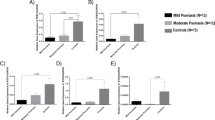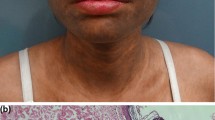Summary
The expression of the interferon regulatory factor 4 (IRF-4) and the IRF-4-binding protein (IBP) in psoriatic skin lesions was investigated. The expression of IRF-4 and IBP in skin lesions of 20 patients with psoriasis vulgaris were immunohistochemically dectected. Normal skin from 10 healthy people was used as normal control. The study showed that expression of IRF-4 was increased significantly in keratinocytes and inflammatory cells in the lesions of psoriasis vulgaris than that in the normal control. The detection revealed that IBP expression in keratinocytes, lymphocytes, hair follicles, and sebaceous glands in normal skin was significantly lower than that in the lesions of psoriasis vulgaris (P<0.05). Both IRF-4 and IBP might be involved in the pathogenesis of psoriasis vulgaris.
Similar content being viewed by others
References
Buckner JH. Mechanisms of impaired regulation by CD4+CD25+FOXP3+ regulatory T cells in human autoimmune diseases. Nat Rev Immunol, 2010,10(12):849–859
Ouyang W, Kolls JK, Zheng Y, et al. The biological functions of T helper 17 cell effector cytokines in inflammation. Immunity, 2008,28(4):454–467
Di Cesare A, Di Meglio P, Nestle FO, et al. The IL-23/Th17 axis in the immunopathogenesis of psoriasis. J Invest Dermatol, 2009,129(6):1339–1350
Brüstle A, Heink S, Huber M, et al. The development of inflammatory T(H)-17 cells requires interferon-regulatory factor 4. Nat Immunol, 2007,8(9):958–966
Gupta S, Lee A, Hu C, et al. Molecular cloning of IBP, a SWAP-70 homologous GEF, which is highly expressed in the immune system. Hum Immunol, 2003,64(4):389–401
Chen Q, Yang W, Gupta S, et al. IRF-4-binding protein inhibits interleukin-17 and interleukin-21 production by controlling the activity of irf-4 transcription factor. Immunity, 2008,29(6):899–911
Canonigo-Balancio AJ, Fos C, Prod’homme T, et al. SLAT/Def6 plays a critical role in the development of th17 cell-mediated experimental autoimmune encephalomyelitis. J Immunol, 2009,183(11):7259–7267
Lowes MA, Kikuchi T, Fuentes-Duculan J, et al. Psoriasis vulgaris lesions contain discrete populations of Th1 and Th17 T cells. J Invest Dermatol, 2008,128(5):1207–1211
Li J, Chen X, Liu Z, et al. Expression of Th17 cytokines in skin lesions of patients with psoriasis. Huazhong Univ Sci Technolog [Med Sci], 2007,27(3):330–332
Huber M, Brüstle A, Reinhard K, et al. IRF4 is essential for IL-21-mediated induction, amplification, and stabilization of the Th17 phenotype. Proc Natl Acad Sci USA, 2008,105(52):20 846–20 851
Caruso R, Botti E, Sarra M, et al. Involvement of interleukin-21 in the epidermal hyperplasia of psoriasis. Nat Med, 2009,15(9):1013–1015
Shaffer AL, Emre NC, Romesser PB, et al. IRF4: Immunity. Malignancy! Therapy? Clin Cancer Res, 2009, 15(9):2954–61
Gualco G, Weiss LM, Bacchi CE. MUM1/IRF4: A review. Appl Immunohistochem Mol Morphol, 2010,18(4): 301–310
Biswas PS, Bhagat G, Pernis AB. IRF-4 and its regulators: evolving insights into the pathogenesis of inflammatory arthritis? Immunol Rev, 2010,233(1):79–96
Fanzo JC, Yang W, Jang SY, et al. Loss of IRF-4-binding protein leads to the spontaneous development of systemic autoimmunity. J Clin Invest, 2006,116(3):703–714
Xiao S, Jin H, Korn T, et al. Retinoic acid increases Foxp3+ regulatory T cells and inhibits development of Th17 cells by enhancing TGF-beta-driven Smad3 signaling and inhibiting IL-6 and IL-23 receptor expression. J Immunol, 2008,181(4):2277–2284
Biswas PS, Gupta S, Chang E, et al. Phosphorylation of IRF4 by ROCK2 regulates IL-17 and IL-21 production and the development of autoimmunity in mice. J Clin Invest, 2010,120(9):3280–3295
Nurieva RI, Dong C. Keeping autoimmunity in check: How to control a Th17 cell controller. Immunity, 2008,29(6):841–843
Author information
Authors and Affiliations
Corresponding author
Additional information
This project was supported by grants from the National Natural Sciences Foundation of China (No. 30972654 and No. 81171495).
Rights and permissions
About this article
Cite this article
Ni, A., Chen, H., Wu, Y. et al. Expression of IRF-4 and IBP in skin lesions of patients with psoriasis vulgaris. J. Huazhong Univ. Sci. Technol. [Med. Sci.] 32, 287–290 (2012). https://doi.org/10.1007/s11596-012-0050-6
Received:
Published:
Issue Date:
DOI: https://doi.org/10.1007/s11596-012-0050-6




